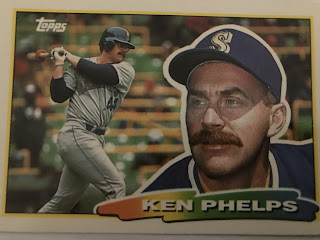I've gotten comments a few times about how I can tell what stadium a card photo was taken in, so I figured I'd write a post about it.
Basically, it's something I noticed almost incidentally as a kid in the late 80's and early 90's, buying cards (and originally stickers too) and having a lot of time to watch baseball on TV. When I first started watching baseball in the late 1980s, we got not only the Yankees and Mets but the Braves on TBS and the Red Sox on WSBK. We eventually lost WSBK but a few years later got WGN with some Cubs and White Sox games.
Without even trying to, I would recognize most team's home ballparks. And with cards it was easy enough to tell, because if you saw players in their home uniform in a park, you knew which park it was.
Nowadays, with all the uniform-looking parks, and with having a lot less time to watch anyone other than the Yankees (and following games on the internet more than watching live), I have no idea where most current cards are taking place.
One thing that made baseball cards even easier is that most photos are taken from one of a few locations. Probably the most common single location for a card photo is the side view of the batter, with the dugout or fence visible behind them. I went through a few piles of Topps cards from the junk wax era to provide a little guide of the parks I would see most often on cards. If people are particularly interested, I could try a similar post for other angles of photos.
Yankee Stadium's dugout had a white roof, and the seats behind were blue, with white railings.
So if you see a batter in front of this background, the photo was at Yankee Stadium.
Tiger Stadium had similar seats to Yankee Stadium, but without the railings. The notable feature at Tiger Stadium is the thick blue roof on the dugout.
So if you see a photo with this dugout (and there are also lots of great photos in this famous dugout), it's at Tiger Stadium.
Sometimes you don't see a dugout but a fence. County Stadium in Milwaukee had a very noticeable red fence.
So if you see that red fence on a card, it's County Stadium.
So if you see this background, it's a spring training game at West Palm Beach.
Comiskey Park didn't have much of a dugout or fence in view but those bright yellow railings were probably the most prominent of any park.
So if you see those bright yellow rails, it's a game in Comiskey.
Shea Stadium's dugout was very similar to that of Tiger Stadium, with a thick blue dugout roof. However the Shea dugout was not nearly as "dug out" and is much higher, plus the layout of Shea allowed a lot more sun in. But sometimes the easiest way to tell the difference is that there were no interleague games at this time.
Oakland's dugout was angled in such a way that a lot of roof was visible. It was yellow but often looked white in photos with the sun on it.
So if you see this background, the game is in Oakland.
The dugouts in Anaheim had a big red (orange?) railing in front of them.
So if you see that background, it's an Angels game.
Dodger Stadium's dugout roofs were similar to Yankee Stadium's, thin and white from this angle. The yellow seats in the stands, as well as the overall larger dugout are the biggest differences.
This background means it's a Dodgers game.
Most of the ballpark with those big walk-in dugouts with no steps were in domes and didn't make card photos in this era. One exception was Jack Murphy Stadium in San Diego, with huge dark dugout areas that dominated card backgrounds.
So if you see this background, you're in San Diego.
One of the easiest locations to identify is Wrigley Field. These days lots of stadiums have faux brick designs, but Wrigley has had the real thing since 1914.
So if you see this in the background, it's a Cubs game.
Cleveland Stadium had yellow dugout roofs, but much narrower than Oakland, and at a very different angle so you usually got a blue fence in the photo.
So if you see this background, you're in Cleveland.
Candlestick Park had orange walls, befitting the Giants team colors.
So if you see this background, it's a Giants game.
Finally, if you see a green wall in the background, you can assume it's the iconic green of Fenway Park.




























You have a lot better handle on stadium railings and seats than I do. I just know Wrigley's brick, the Comiskey yellow railings and to look for the Yankee Stadium frieze. Otherwise I'm usually lost.
ReplyDeleteVery informative. My brain won't retain 98% of this though. Usually the only way I can recognize the handful of stadiums I'm familiar with is by looking at the outfield or upper deck. As many times that I've been to the Oakland Coliseum... I can't pick out their dugouts.
ReplyDeleteAn informative post.
ReplyDeleteThat was really helpful - I had no idea.
ReplyDeleteImpressive!
ReplyDeleteYou might want to think about adding a tab for this post, that way folks can always come back and find it if need be. Plus too, it would allow you to add more to it if you ever think of/come across any more tells.
ReplyDelete